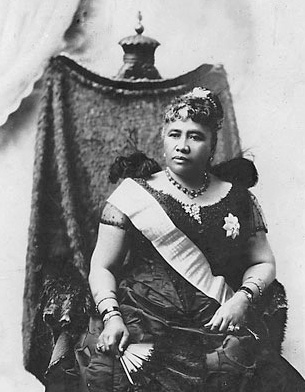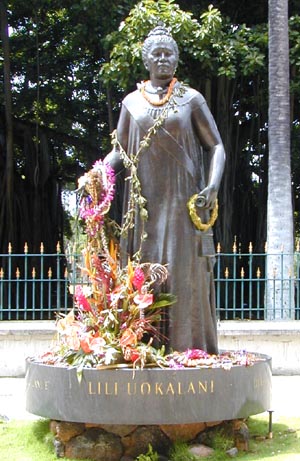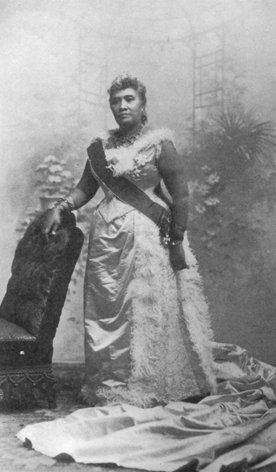<Back to Index>
- Chemist Friedrich Wilhelm Ostwald, 1853
- Poet Esteban Echeverría, 1805
- Queen of the Hawaiian Islands Liliuokalani, 1838
PAGE SPONSOR



Liliʻuokalani (2 September 1838 – 11 November 1917), born Lydia Kamakaʻeha Kaola Maliʻi Liliʻuokalani, was the last monarch and only queen regnant of the Kingdom of Hawaiʻi. She was also known as Lydia Kamakaʻeha Pākī, with the chosen royal name of Liliʻuokalani, and her married name was Kaolupoloni K. Dominis.
Liliʻuokalani was born on 2 September 1838 to High Chiefess Analea Keohokalole and High Chief Caesar Kaluaiku Kapaʻakea. In accordance with Hawaiian tradition, she was adopted at birth by Abner Pākī and his wife Laura Kōnia. Liliuokalani’s childhood years were spent studying and playing with her foster sister Bernice Pauahi, the Pākīs' natural daughter. The Premier Elizabeth Kīnaʻu had developed an eye infection at the time of Liliʻu's birth. She gave her the names Liliʻu (smarting), Loloku (tearful), Walania (a burning pain), and Kamakaʻeha (sore eyes), translated as Lydia Smarting Tearful Anguish the Sore Eyes. Liliʻu's brother changed it when he named her Crown Princess, calling her Liliʻuokalani, "the smarting of the royal ones". Liliʻuokalani received her education at the Royal School (originally known as the Chiefs' Children School), and became fluent in English. She attended the school with her two elder brothers James Kaliokalani and David Kalākaua. Liliuokalani was one of 15 children.
On 16 September 1862, Liliʻuokalani married John Owen Dominis, who became Governor of Oʻahu and Maui. Although Liliʻuokalani's named successor was her niece Princess Kaʻiulani (1875 – 1899), Kaʻiulani predeceased her. Liliʻuokalani had three hanai children: Lydia Kaʻonohiponiponiokalani Aholo; Kaiponohea ʻAeʻa, the son of a retainer; and John Dominis. In 1874, Lunalilo, who was elected to succeed Kamehameha V to the Hawaiian throne, died and left no heir to succeed to the throne. In the election that followed, Liliʻu's brother, David Kalākaua, ran against Queen Emma, the widowed Queen of Kamehameha IV. Liliʻuokalani sided with her family on the issue and a sort of quarrel developed between the Kalākaua family and Queen Emma. Liliʻu
denied that Emma had any claims to the throne other than those derived
from her dead husband. The Kalākaua family strongly stated that Kaleipaihala was the ancestor of Queen Emma rather than Kealiimakai because this would give the dowager Queen no claim as the great-grandniece of Kamehameha the Great. Each party viewed themselves as the greatest chief and the rightful heir the throne of the Kamehamehas. In
the election that followed, Kalākaua won a majority of the vote of the
Legislature and was anointed the new king of Hawaii. Queen Emma never
forgave Liliʻu and her position in the family which was chosen to reign over the Hawaiian people. Liliʻu
said: "It did not trouble me at all, but I simply allowed her to remain
in the position in which she chose to place herself." One of the first
acts of Kalākaua was to name his brother heir-apparent. He also granted
other royal titles to his two surviving sisters, Liliʻuokalani and Likelike. With Liliʻu's younger brother's death in 1876, the position of heir-apparent became vacant. Princess Ruth Keelikolani offered
to fill the spot of her adoptive son; this suggestion was placed before
the king's counselors at a cabinet meeting, but it was objected on the
grounds that, if her petition was granted, then Bernice Pauahi Bishop would be the next heir to the throne, as they were first cousins. At noon on April 10, 1877, the booming of the cannon was heard; this announced that Liliʻuokalani
was heir apparent to the throne of Hawaii. From that point on, she was
referred to as "Crown Princess" with the name Liliʻuokalani, given to her by her brother. One of her first acts as Crown Princess was to tour the island of Oʻahu with her husband, sister, and brother-in-law. In April 1887, Kalākaua sent a delegation to attend the Golden Jubilee of England's Queen Victoria. While on the trip, she learned of the Bayonet Constitution that
Kalākaua had been forced, under the threat of death, to sign. She was
so upset that she canceled a tour of the rest of Europe and returned to
Hawaiʻi at once. Liliʻuokalani inherited the throne from her brother Kalākaua on 29 January 1891. Shortly
after ascending the throne, petitions from her people began to be
received from the two major political parties of the time, mainly Hui
Kala'aina and the National Reform Party. Believing she had the support
of her cabinet and that to ignore such a general request from her
people would be against the popular will, she moved to abrogate the
existing 1887 Bayonet Constitution, by
drafting a new constitution that would restore the veto power to the
monarchy and voting rights to economically disenfranchised Native
Hawaiians and Asians. The effort to draft a new constitution never came to fruition, and indeed it was the proximate cause of the overthrow of the Hawaiian Kingdom. Threatened by the queen's proposed new constitution, American and European businessmen and residents organized to depose Liliʻuokalani, asserting that the queen had "virtually abdicated" by refusing to
support the 1887 Constitution. Business interests within the Kingdom
were also upset about what they viewed as "poor governance" of the
Kingdom, as well as the U.S. removal of foreign tariffs in the sugar trade due to the McKinley Tariff. The tariff eliminated the favored status of Hawaiian sugar guaranteed by the Reciprocity Treaty of 1875.
American and Europeans actively sought annexation to the United States
so that their business might enjoy the same sugar bounties as domestic
producers. In addition to these concerns, Lili'uokalani believed that
American businessmen, like Charles R. Bishop, expressed an anxiety
concerning a female head of state. On 14 January 1893, a group composed of Americans and Europeans formed a Committee of Safety seeking
to overthrow the Hawaiian Kingdom, depose the Queen, and seek
annexation to the United States. As the coup d'état was
unfolding on 17 January the Committee of Safety expressed concern for
the safety and property of American citizens. In response, United
States Government Minister John L. Stevens summoned a company of U.S. Marines from the USS Boston and
two companies of U.S. Navy sailors to take up positions at the U.S.
Legation, Consulate, and Arion Hall. On the afternoon of 16 January
1893, 162 sailors and Marines aboard the USS Boston in
Honolulu Harbor came ashore under orders of neutrality. Historian
William Russ has noted that the presence of these troops, ostensibly to
enforce neutrality and prevent violence, effectively made it impossible
for the monarchy to protect itself. The
Queen was deposed on 17 January 1893 and temporarily relinquished her
throne to "the superior military forces of the United States". She had hoped the United States, like Great Britain earlier in Hawaiian history, would restore Hawaii's sovereignty to the rightful holder. Queen
Liliuokalani issued the following statement yielding her authority to
the United States Government rather than to the Provisional Government: A
provisional government, composed of European and American businessmen,
was then instituted until annexation with the United States could be
achieved. On 1 February 1893, the US Minister (ambassador) to Hawaii
proclaimed Hawaii a protectorate of the United States. The administration of Grover Cleveland commissioned the Blount Report, and based on its findings, concluded that the overthrow of Liliʻuokalani was illegal, and that U.S. Minister Stevens and American military
troops had acted inappropriately in support of those who carried out
the overthrow. On 16 November 1893 Cleveland proposed to return the
throne back to her if she granted amnesty to everyone responsible. She
initially refused, and it was reported that she said she would have
them beheaded — she denied that specific accusation, but admitted
that she intended them to suffer the punishment of banishment. With this development, then - President Grover Cleveland sent the issue to the United States Congress.
She later changed her position on the issue of punishment for the
conspirators, and on 18 December 1893 U.S. Minister Willis demanded her
reinstatement by the Provisional Government. The Provisional Government
refused. Congress responded to Cleveland's referral with a U.S. Senate
investigation that resulted in the Morgan Report on
26 February 1894. The Morgan Report found all parties (including
Minister Stevens), with the exception of the queen, "not guilty" from
any responsibility for the overthrow. The
accuracy and impartiality of both the Blount and Morgan reports has
been questioned by partisans on both sides of the historical debate
over the events of 1893. On 4 July 1894, the Republic of Hawaiʻi was proclaimed and Sanford B. Dole,
one of the first people who originally called on the institution of the
monarchy to be abolished, became President. The Republic of Hawaiʻi was recognized by the United States government as a protectorate, although Walter Q. Gresham, Cleveland's Secretary of State, remained antagonistic towards the new government. Liliʻuokalani was arrested on 16 January 1895, several days after the failed 1895 Counter-Revolution in Hawaii led by Robert William Wilcox, when firearms were found in the gardens of her home. She denied any knowledge at her trial, defended by former attorney general Paul Neumann.
She was sentenced to five years of hard labor in prison by a military
tribunal and fined $5,000, but the sentence was commuted to
imprisonment in an upstairs bedroom of ʻIolani Palace, where she composed songs including The Queen's Prayer (Ke Aloha o Ka Haku)
and began work on her memoirs. During
her imprisonment, she abdicated her throne in return for the release
(and commutation of the death sentences) of her jailed supporters,
including Minister Joseph Nawahi, Prince Kawananakoa, Robert Wilcox, and Prince Jonah Kuhio. Before
ascending the throne, for fourteen years, or since the date of my
proclamation as heir apparent, my official title had been simply
Liliuokalani. Thus I was proclaimed both Princess Royal and Queen. Thus
it is recorded in the archives of the government to this day. The
Provisional Government nor any other had enacted any change in my name.
All my official acts, as well as my private letters, were issued over
the signature of Liliuokalani. But when my jailers required me to sign
("Liliuokalani Dominis,") I did as they commanded. Their motive in this
as in other actions was plainly to humiliate me before my people and
before the world. I saw in a moment, what they did not, that, even were
I not complying under the most severe and exacting duress, by this
demand they had overreached themselves. There is not, and never was,
within the range of my knowledge, any such a person as Liliuokalani
Dominis. Following her release, she was placed under house arrest for a year and in 1896, the Republic of Hawaiʻi gave her a full pardon and restored her civil rights. She
then made several trips to the United States to protest against the
annexation by the United States and attended the inauguration of US
President McKinley with a Republic of Hawaiʻi passport personally issued to "Liliʻuokalani of Hawaiʻi" by President Dole. In 1898, Hawaiʻi became an incorporated territory of the United States during the Spanish American War and took control of the 1,200,000 acres (4,900 km2) of land that formerly was held in trust by the monarchy and known as "Crown Land". This later would become the source of the "Ceded Lands" issue in Hawaiʻi. In 1900, the US Congress passed the Hawaiʻi Organic Act establishing a government for the Territory of Hawaii. From
1905 to 1907, the Queen entered claims against the U.S. totaling
$450,000 for property and other losses, claiming personal ownership of
the crown lands, but was unsuccessful. The territorial legislature of
Hawaii finally voted her an annual pension of $4,000 and permitted her
to receive the income from a sugar plantation of 6,000 acres
(24 km²), which was the private property of her late brother
before his election as king. In
1910, Liliuokalani brought an unsuccessful lawsuit against the United
States seeking compensation under the Fifth Amendment for the loss of
the Hawaiian crown land. The Queen was also remembered for her support of Buddhist and Shinto priests in Hawaiʻi and became one of the first Native Hawaiians to attend a Vesak Day (Buddha's
Birthday) celebration of 19 May 1901 at the Honwangji mission. Her
attendance in the celebration had helped Buddhism and Shintoism gain
acceptance into Hawaiʻi's
society and prevented the possible banning of those two religions by
the Territorial government. Her presence was also widely reported in
Chinese and Japanese newspapers throughout the world and earned her the
respect of many Japanese people both in Hawaiʻi and in Japan itself. She lived in Washington Place until her death in 1917 due to complications from a stroke. She was 79. Upon her death, Liliʻuokalani dictated in her will that all of her possessions and properties be sold and the money raised would go to the Queen Liliʻuokalani Children's Trust to help orphaned and indigent children. The Queen Liliʻuokalani Trust Fund is still in existence today. Liliʻuokalani was an accomplished author and songwriter. Her book, Hawaiʻi's Story by Hawaiʻi's Queen, gave her view of the history of her country and her overthrow and therefore became the first Native Hawaiian female author. Liliʻuokalani was known for her musical talent. Lili'u is said to have played guitar, piano, organ, ʻukulele and zither.
She also sang alto, performing Hawaiian and English sacred and secular
music. She would find herself in music. In her memoirs she wrote: To
compose was as natural to me as to breathe; and this gift of nature,
never having been suffered to fall into disuse, remains a source of the
greatest consolation to this day.[…] Hours of which it is not yet in
place to speak, which I might have found long and lonely, passed
quickly and cheerfully by, occupied and soothed by the expression of my
thoughts in music. Liliʻuokalani
helped preserve key elements of Hawaii's traditional poetics while
mixing in Western harmonies brought by the missionaries. A compilation
of her works, titled The Queen's Songbook, was published in 1999 by Liliʻuokalani Trust.
—Queen Liliuokalani, "Hawaii's Story By Hawaii's Queen"